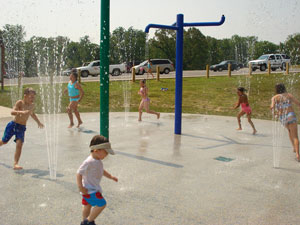Community
Overview

View looking east, of the Harpeth River from the Challenge Trail
Many residents of Kingston Springs can trace their lineage to the area. If you were to speak with them, you would hear tales of the old Kingston Springs hotel, rich and famous visitors to town, and personal connections to both Nashville and the local springs which made the area famous. Through this connection, most members of the community are especially invested and engaged in the future of the town.
Local Economy
Additionally, Kingston Springs has three major assets to tourism development; the Harpeth River, an historic downtown area, and close proximity to Interstate 40 and downtown Nashville. Each of these assets make our community a more attractive place for tourism and potential growth.
History
Lewis Dunn was the earliest known white settler of Kingston Springs. He received a land grant for his service during the Revolutionary War and in 1807, settled with his family near the Harpeth River.
A large hotel and tavern was constructed in 1819 near mineral springs to accommodate visitors seeking the healing qualities of Kingston Springs' white, black and red sulfur water. The springs served as the primary local attraction throughout the 1850s, and were advertised in the Nashville Union and American newspaper in 1855.

One of the several local saw mills in the Kingston Springs area

Chief Ed Bruce and the town's first fire engine
The 'Town of Kingston Springs' was formally incorporated in 1965 with a population of 290. W. R. Mayes served as the first Mayor from 1966 to 1974 and John Sweaney served as the first City Manager, also from 1966 to 1974. Since that time, Kingston Springs has developed and grown services. In August 1974, the National Life and Accident Insurance Company donated 30 acres of land along the Harpeth River to serve as the community's first park. Municipal sewer service was added in 1984 and has expanded to account for nearly three quarters of businesses and residences inside the jurisdictional limits today.
Despite a devastating 1,000 year flood event which occurred in May 2010, Kingston Springs has recently experienced broad-based growth and investment. The town has both over 2,000 residents and several businesses inside the jurisdictional limits. It also has the area's largest residential subdivision just outside its limits. Nearby Metropolitan Nashville has had such explosive growth recently, many residents and visitors are refreshed by the relative small-town feel and scenic beauty of the area. 11,000 people reside within 5 miles of Kingston Springs and nearly all of them frequent town roads, schools, and businesses daily.

Flood of May, 2010
Cultural & Recreational Highlights
Within the Downtown Area

Stump Carving by local Craftsman, Lundy Cupp
Since 2000, the town has focused on developing its historic downtown. It adopted historic downtown specific language to its Design Guidelines Manual in 2003, and fine tuned language in its zonnig ordinance to preserve the feel of the area. In 2009, the Town debt financed a major capital project in the downtown area. The project allowed for a new sewer main to be installed running the length of the downtown, a repaving of North Main Street, a new parking surface lot was constructed, pavement markings were added throughout the downtown, and new street lighting was installed. As part of the FY16 budget, the town will be adding a 'history of Kingston Springs' walking trail with stops in and around the downtown. The project is aimed at commemorating local history during the 50th anniversary of the Town's incorporation, spreading civic awareness and pride, and increasing the heritage tourism offerings for visitors.
Near the Downtown Area
The downtown is only within a few miles drive of two scenic and historic sites; Harpeth River State Park and Mound Bottom area. Narrows of the Harpeth includes an incised meander and an associated national historic landmark, the Montgomery Bell Tunnel. The tunnel is a man-made water feature from 1818 which directed water for a historic iron manufacturing operation known as Pattison Forge. Mound Bottom State Park features the remnants of a Native American ceremonial meeting place dating from around 950 AD. Over time, the site developed as a fortified city with a population numbering in the thousands and diminished around the year 1300 AD. The site is closed to the public, but guided tours are given through the Tennessee State Parks Department.
Another area attraction, L.L. Burns Park, is located within walking distance of the downtown area. The municipal park was donated by Col. William J. Burns to the Town of Kingston Springs in 1998 and has since undergone a million dollar renovation. The park is framed by the beautiful Harpeth River and features athletic fields, playgrounds, miles of paved and unpaved trails, a nine-hole disc golf course, a fishing pond, and a splash pad. Additionally, an activity center and pavilions and can be rented from the town. The park is the site of several annual community events, including the Art in the Park festival. Art in the Park is an all-day free event which showcases more than one hundred local arts and artisans vendors. The event is held on the first Saturday of October.

L.L. Burns Park Splash Pad
